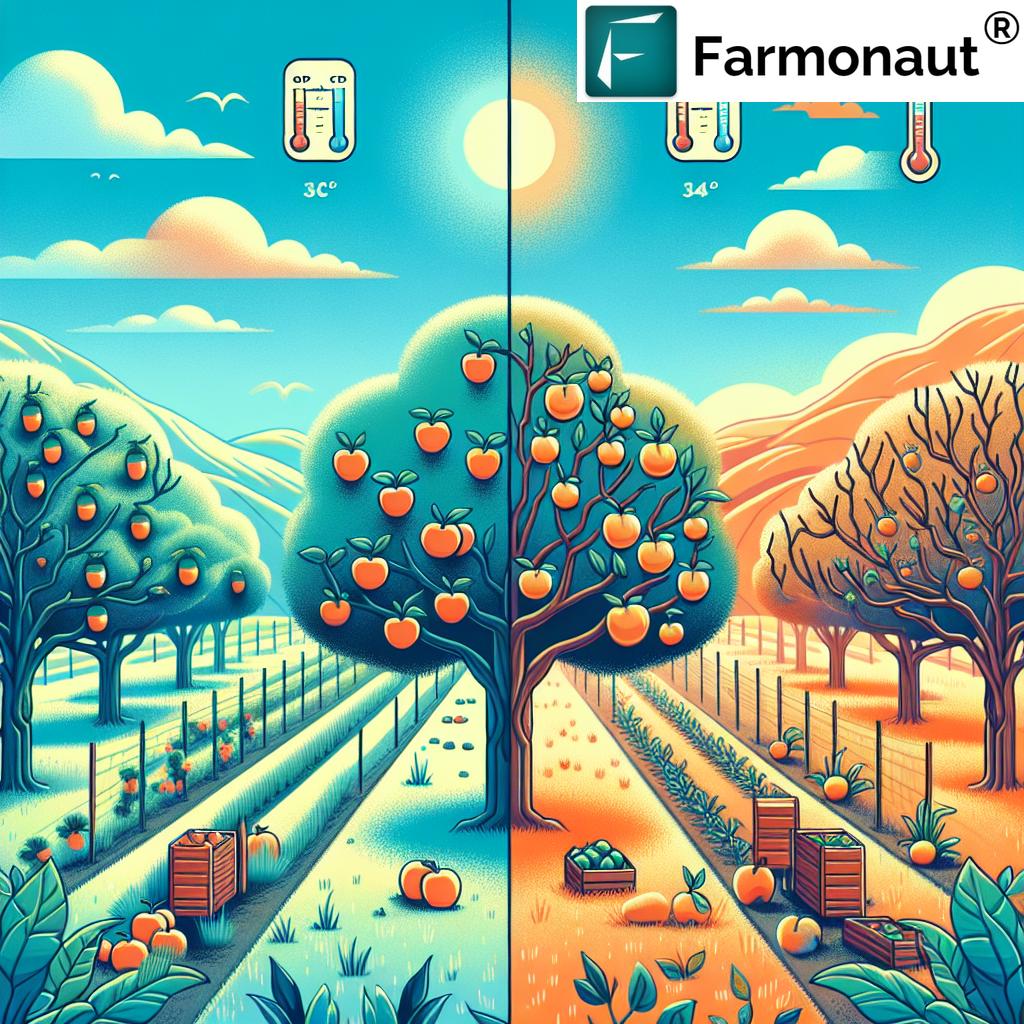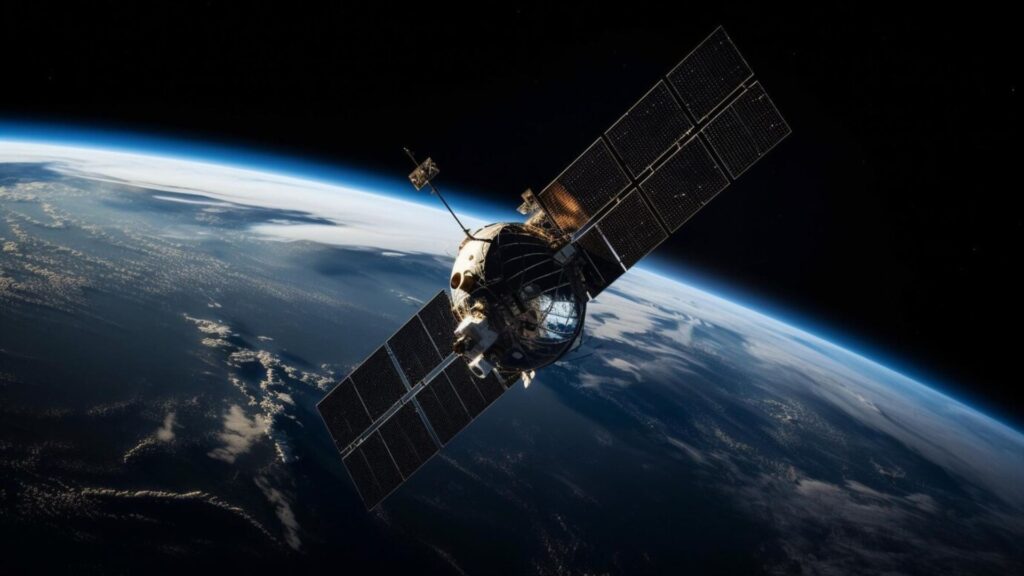
Understanding Chill Hours: Essential for Fruit Tree Success in Temperate Regions
At Farmonaut, we understand the importance of chill hours for fruit trees in temperate climates. Our advanced satellite-based technology and AI-driven insights help farmers and orchardists optimize their fruit tree management, ensuring better yields and healthier trees. In this comprehensive guide, we’ll explore the concept of chill hours, their significance for fruit trees, and how our innovative solutions can help you track and manage this crucial aspect of fruit tree cultivation.
What Are Chill Hours?
Chill hours, also known as chilling requirements, refer to the number of hours during the winter period when temperatures fall within a specific range, typically between 32°F and 45°F (0°C to 7°C). This period of cool temperatures is essential for many fruit trees native to temperate regions, as it triggers their natural dormancy cycle and prepares them for proper growth and fruiting in the following spring and summer.
The Importance of Chill Hours for Fruit Trees
Chill hours play a crucial role in the life cycle of fruit trees, particularly those adapted to temperate climates. Here’s why they’re so important:
- Dormancy regulation: Chill hours help trees enter and maintain a state of dormancy during winter, protecting them from cold damage.
- Bud break synchronization: Adequate chilling ensures that buds break dormancy uniformly in spring, leading to even flowering and fruit set.
- Fruit quality: Proper chilling contributes to better fruit quality, size, and overall yield.
- Tree health: Meeting chilling requirements helps maintain the overall health and vigor of fruit trees.
Chill Hour Requirements for Different Fruit Tree Varieties
Different fruit tree varieties have varying chill hour requirements based on their genetic makeup and native regions. Here’s a table comparing chill hour requirements for common fruit tree types, along with how Farmonaut’s system can assist in monitoring and managing these requirements:
| Fruit Tree Type | Chill Hour Range | Farmonaut’s Monitoring Capabilities |
|---|---|---|
| Apple | 500-1000 | Farmonaut’s satellite-based system tracks local temperatures, calculates accumulated chill hours, and provides real-time alerts for optimal dormancy management across various climates. Our AI-driven insights help orchardists choose suitable varieties for their specific locations and adapt to changing climate conditions. |
| Pear | 600-900 | |
| Peach | 200-1000 | |
| Cherry | 800-1200 | |
| Plum | 700-1000 |
Factors Affecting Chill Hour Accumulation
Several factors can influence the accumulation of chill hours in a given location:
- Latitude: Generally, higher latitudes experience more chill hours due to longer, colder winters.
- Elevation: Higher elevations tend to have cooler temperatures, potentially increasing chill hour accumulation.
- Microclimates: Local topography, bodies of water, and urban heat islands can create microclimates that affect chill hour accumulation.
- Climate change: Global warming trends may impact chill hour accumulation in traditional fruit-growing regions.
How Farmonaut Helps Track and Manage Chill Hours
At Farmonaut, we leverage cutting-edge satellite technology and AI to provide precise, real-time data on local temperatures and chill hour accumulation. Our comprehensive platform offers several benefits for fruit tree growers:
- Accurate temperature monitoring: Our satellite-based system tracks local temperatures with high precision, ensuring reliable chill hour calculations.
- Real-time chill hour tracking: Growers can monitor chill hour accumulation throughout the winter period, making informed decisions about orchard management.
- Customized alerts: We provide timely notifications when specific chill hour thresholds are reached, helping growers plan their dormancy-breaking treatments and spring activities.
- Historical data analysis: Our platform allows users to access and analyze historical temperature and chill hour data, enabling better long-term planning and variety selection.
- Climate adaptation insights: By analyzing temperature trends and chill hour patterns, we help growers adapt their orchards to changing climate conditions.
To access these powerful tools and more, visit our Farmonaut app or explore our API services for integration with your existing systems.

Understanding Dormancy in Fruit Trees
Dormancy is a crucial phase in the life cycle of deciduous fruit trees, allowing them to survive harsh winter conditions and synchronize their growth with seasonal changes. Let’s delve deeper into the dormancy process and its relationship with chill hours:
Stages of Dormancy
- Para-dormancy: This occurs in late summer and early fall when trees begin to slow their growth in response to shorter days and cooler temperatures.
- Endo-dormancy: The main winter dormancy period, triggered by exposure to chilling temperatures. This is when chill hour accumulation is most critical.
- Eco-dormancy: The final stage of dormancy, where trees are ready to resume growth but are held back by unfavorable environmental conditions.
The Role of Chill Hours in Breaking Dormancy
Chill hours play a vital role in breaking endo-dormancy and preparing trees for spring growth. Here’s how it works:
- Exposure to chilling temperatures triggers biochemical changes within the tree’s buds.
- These changes gradually break down growth inhibitors and promote the production of growth stimulators.
- Once the required number of chill hours is met, the tree becomes capable of resuming growth when temperatures warm up in spring.
Chill Hour Models and Calculation Methods
Several models have been developed to calculate chill hours, each with its own strengths and applications. At Farmonaut, we use advanced algorithms to provide accurate chill hour calculations based on the most suitable model for your specific location and crop. Here are some common chill hour models:
1. Traditional Chill Hour Model
This simple model counts the number of hours when temperatures are between 32°F and 45°F (0°C to 7°C). While straightforward, it may not account for the varying effects of different temperatures within this range.
2. Utah Model
This more complex model assigns different chill unit values to various temperature ranges, accounting for both positive and negative effects on dormancy breaking.
3. Dynamic Model
Developed in Israel, this model considers the sequential nature of chill accumulation and is particularly useful in warmer climates.
4. Modified Positive Chill Unit Model
An adaptation of the Utah Model that only considers positive chill unit accumulation, useful in areas with fluctuating winter temperatures.
Our Farmonaut platform utilizes these models and more, automatically selecting the most appropriate calculation method based on your location and fruit tree varieties. This ensures you receive the most accurate and relevant chill hour data for your orchard.
Adapting to Climate Change: Challenges and Strategies
As climate patterns shift globally, many traditional fruit-growing regions are experiencing changes in their chill hour accumulation. This poses significant challenges for orchardists and the fruit industry as a whole. At Farmonaut, we’re committed to helping growers adapt to these changes through data-driven insights and innovative solutions.
Climate Change Impacts on Chill Hours
- Reduced chill hour accumulation: Many regions are seeing fewer chill hours due to warmer winters.
- Increased temperature fluctuations: More frequent warm spells during winter can negatively impact dormancy and bud development.
- Shifting growing zones: Traditional fruit-growing areas may become less suitable for certain varieties.
Adaptation Strategies
- Variety selection: Choose fruit tree varieties with lower chill hour requirements or those better adapted to your changing local climate.
- Rootstock considerations: Experiment with rootstocks that may influence a tree’s chill hour requirements or overall cold hardiness.
- Orchard site selection: Consider microclimate factors when planting new orchards to maximize chill hour accumulation.
- Cultural practices: Implement techniques such as shade cloth or evaporative cooling to manipulate orchard microclimates.
- Dormancy-breaking treatments: Explore the use of chemicals or other methods to compensate for insufficient natural chilling.
Farmonaut’s satellite-based monitoring and AI-driven insights can help you implement these strategies effectively by providing accurate, real-time data on your orchard’s microclimate and chill hour accumulation.
Chill Hour Management Techniques
Proper management of chill hours is crucial for maintaining healthy, productive fruit trees. Here are some techniques that, when combined with Farmonaut’s precise monitoring capabilities, can help you optimize your orchard’s performance:
1. Precision Pruning
Timing your pruning activities based on chill hour accumulation can help promote balanced growth and fruit production. Our real-time alerts can notify you when optimal pruning windows approach.
2. Dormancy-Breaking Sprays
In years with insufficient chilling, carefully timed applications of dormancy-breaking chemicals can help compensate. Farmonaut’s chill hour tracking ensures you apply these treatments at the most effective time.
3. Protective Measures
During unusually warm winter periods, techniques like shade cloth or overhead misting can help maintain cooler temperatures and continue chill hour accumulation. Our system can alert you to these warm spells, allowing for timely intervention.
4. Variety and Rootstock Selection
For new plantings or orchard renovations, use our historical chill hour data to select varieties and rootstocks best suited to your local climate trends.
Leveraging Farmonaut’s Technology for Optimal Chill Hour Management
Our advanced platform offers a suite of tools designed to help you master chill hour management:
- Satellite-based temperature monitoring: Get precise, real-time temperature data for your specific orchard location.
- AI-driven chill hour calculations: Our system automatically applies the most appropriate chill hour model for your region and fruit varieties.
- Custom alerts and notifications: Receive timely updates on chill hour accumulation, critical thresholds, and optimal management windows.
- Historical data analysis: Access and analyze past chill hour trends to inform long-term orchard planning and variety selection.
- Integration with other farm management tools: Seamlessly incorporate chill hour data into your broader orchard management strategy.
To harness the power of these tools, download our mobile app for Android or iOS, or explore our API documentation for custom integrations.
Case Studies: Success with Farmonaut’s Chill Hour Management
While we don’t provide specific case studies, our technology has helped numerous orchardists across various temperate regions optimize their chill hour management. Growers using our platform have reported:
- Improved timing of dormancy-breaking treatments
- Better synchronization of orchard management activities
- Increased fruit quality and yield consistency
- Enhanced ability to adapt to changing climate conditions
- More informed decision-making for new variety selections and orchard expansions
Future Trends in Chill Hour Management
As climate change continues to impact fruit-growing regions, the importance of precise chill hour management will only increase. At Farmonaut, we’re continually innovating to stay ahead of these challenges:
- Machine learning advancements: Improving our predictive models for chill hour accumulation and climate trends.
- Integration with IoT devices: Combining satellite data with ground-based sensors for even more precise microclimate monitoring.
- Automated management recommendations: Developing AI-driven systems that provide tailored advice based on real-time chill hour data and other orchard parameters.
- Climate-resilient variety development: Collaborating with researchers to identify and promote fruit tree varieties better adapted to changing chill hour patterns.
FAQs About Chill Hours and Fruit Tree Management
Q: What happens if fruit trees don’t receive enough chill hours?
A: Insufficient chilling can lead to delayed or uneven bud break, reduced fruit set, and overall poor tree performance. In severe cases, it may result in little to no fruit production for that season.
Q: Can trees accumulate too many chill hours?
A: While excess chilling is generally not harmful, it can lead to earlier bud break, potentially exposing new growth to late spring frosts. Our monitoring system helps you track this risk and take protective measures if needed.
Q: How do I know which chill hour model is best for my orchard?
A: The most appropriate model depends on your local climate and fruit varieties. Farmonaut’s system automatically selects and applies the best model for your specific situation, ensuring accurate chill hour calculations.
Q: Can I influence chill hour accumulation in my orchard?
A: While you can’t control the weather, techniques like site selection, variety choice, and microclimate manipulation (e.g., shade cloth, evaporative cooling) can help optimize chill hour accumulation. Our platform provides the data you need to implement these strategies effectively.
Q: How does Farmonaut’s satellite technology compare to on-site weather stations for chill hour tracking?
A: Our satellite-based system offers several advantages, including broader coverage, no maintenance requirements, and integration with advanced AI analytics. However, it can be complemented by ground-based sensors for even more precise data in specific microclimates.
Conclusion: Mastering Chill Hours with Farmonaut
Understanding and managing chill hours is crucial for successful fruit tree cultivation in temperate regions. As climate patterns continue to shift, the need for precise, data-driven orchard management becomes increasingly important. At Farmonaut, we’re committed to providing cutting-edge tools and insights to help you navigate these challenges and optimize your fruit tree production.
By leveraging our satellite-based monitoring, AI-driven analytics, and comprehensive management platform, you can:
- Accurately track chill hour accumulation in real-time
- Make informed decisions about variety selection and orchard planning
- Optimize the timing of critical management activities
- Adapt your orchard practices to changing climate conditions
- Improve overall fruit quality and yield consistency
Don’t let uncertain chill hour patterns impact your orchard’s success. Embrace the power of precision agriculture with Farmonaut and take control of your fruit tree management today.
Ready to revolutionize your orchard management? Subscribe to Farmonaut now and start harnessing the power of satellite-based monitoring and AI-driven insights for your fruit trees:












